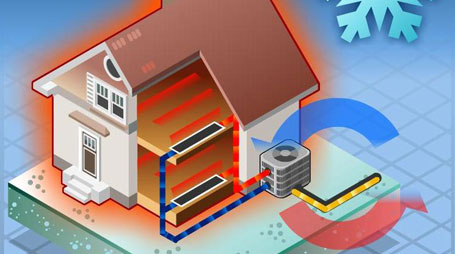Ducted Reverse Cycle
There are many many benefits to ducted reverse cycle air conditioning;
- Less obvious than traditional heaters, standards fans, ceiling fans & split systems
- Distributes the heating & cooling more evenly – making all areas of your home or workplace comfortable & useable.
- Increases the value of your home - Real estate agents confirm this as an asset to any home.
- Running costs are 75% less than conventional electric heaters & LPG gas heaters, dispelling the myths that it is an expensive option to heat your home.
Heating & Cooling
Ducted air conditioning comprises of an electrically powered refrigeration system that provides cool dehumidified air. But when the operating cycle is reversed the same system provides abundant warm air.
The system usually comprises of 2 parts;
- an outdoor motor that does the hard work with insulated copper pipes that run to,
- an indoor fan coil unit located in the ceiling or under the house.
From the fan coil unit, insulated flexible ducts distribute the cool or warm air to grilles in each area.
In-Ceiling
Ducted systems can be installed in a suitable ceiling space of a home / premises. A ceiling must have adequate height & accessibility to comply with installation requirements.
In-ceiling ducting delivers heating & cooling to several areas of a home / premises. Common misconceptions are;
- That heating from the ceiling is less effective than floor level heating.
- That cooling from the floor level is less effective than ceiling level cooling.
A suitably designed in-ceiling system is as equally efficient as an under floor system for both heating & cooling.
Under Floor
Ducted systems can also be installed in a suitable under floor where there is adequate space of a home / premises. The heating & cooling unit that supplies the ducting system can be installed under premises or discretely at the side of building.
Under floor systems offer the advantage of easy access to the air grills for manual open & closing to control air flow.
Inverter Technology
Outdoor motor automatically varies its speed to maintain the optimal temperature whilst using minimal energy (electricity).
Inverter technology has been proven to use 30% less energy than old technology, making it now a popular choice to upgrade old systems.
Noise Reduction – Inverter technology also ensures that both indoor & outdoor units are almost silent.
Zoning
Zones can be created to isolate 1 or more areas. Zones can then be turned on or off individually to optimise the running of the system e.g. turning off areas that are not being used such as bedrooms during the day, making the system more energy efficient.
Zones may be controlled manually from switches, time clocks & / or thermostats depending upon the level of control desired.
Zones can also be individually temperature controlled to suit individual needs, keeping everyone happy!!
Multiple Thermostats
A single thermostat is the most common method of controlling a heating & cooling system. However multiple thermostats can be installed to give greater options to personalise the heating & cooling of different zones.
VRF Technology
Variable Refrigerant Flow (VRF) is sometimes referred to Variant Refrigerant Volume (VRV).
VRF & VRV are innovative climate control technologies that allow for changes in temperature in different parts of a building at different times of day. The user simply sets the ambient temperature required and the system will maintain the room at that temperature no matter what happens outside or in the next room.
VRF & VRV is now available in a gas powered system relying on minimal electricity to only operate the fan & controls, enabling significantly lower running costs as well as lowering your carbon footprint.
